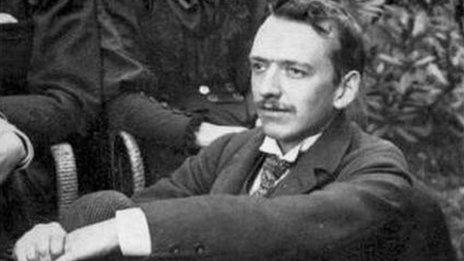Charles Thomson Rees Wilson: The man who made clouds
- Published

Charles Thomson Rees Wilson was inspired by cloud formations on Ben Nevis
The huge contribution made by an often-overlooked Nobel prize-winning Scottish scientist is being celebrated at a special conference at the Royal Society of Edinburgh.
The only Scottish-born physicist ever to have won the Nobel Prize for Physics, Charles Thomson Rees Wilson was inspired by the cloud formations he had witnessed on Ben Nevis.
He started out attempting to recreate clouds in his laboratory, but his invention and experiments led on to massive strides in the science of particle physics.
The search for the Higgs Boson at the Large Hadron Collider is the latest stage in the hunt for answers about fundamental particles of life.
However, in the late 19th Century, very little was known about protons, neutrons and electrons. Photons, neutrinos, muons and quarks were a long way from being discovered.
Dr Alexander Mackinnon, honorary research fellow (Physics and Astronomy) at the University of Glasgow, says Wilson's cloud chamber, which he developed over almost 20 years, "made things visible whose properties had only previously been deduced indirectly".
"When the cloud chamber was invented people already had a pretty rough idea of what an electron was and how it would behave," he said.
For 40 years, the cloud chamber was the most important instrument for studying sub-atomic particles
"In a cloud chamber they could actually see those things happening.
"They could check they were true and in due course, when they discovered other sorts of particles, they could inspect their properties visually."
Dr Mackinnon says that for a period of about 40 years after it was perfected in about 1911, the cloud chamber was the most important instrument for studying sub-atomic particles.
It was superseded in the 1950s by the Bubble Chamber, which used liquid hydrogen, and then by later technologies. However, its use coincided with an age in which massive strides were made.
Wilson was given the Nobel Prize in 1927 "for his method of making the paths of electrically charged particles visible by condensation of vapour" - but essentially it was for his invention of the cloud chamber.
It all began back in September 1894, when the 25-year-old son of a farmer from Glencorse, near Edinburgh, had been working at the meteorological observatory in the Scottish Highlands.
He was struck by the beauty of "glories" - coloured rings surrounding shadows cast on mist and cloud.
Wilson's cloud chamber enabled the discovery of anti-matter particles
When he went back to Cambridge, where he had been at university, he set to work at the Cavendish laboratory, with the aim of making clouds.
He found that if you had air saturated with water vapour in a sealed container and suddenly expanded the volume in which it was contained, you could get clouds to form.
His experiments coincided with the discovery of x-rays. He found that when he fired them into his chamber, it clouded up more quickly than it did through expansion.
Alan Walker, an honorary fellow of the School of Physics and Astronomy at Edinburgh University, says Wilson made possible the pioneering work for looking at the tracks of particles.
He says: "A lot of particle physics discoveries in the 1930s, 40s and 50s were done with cloud chambers.
"Before him there was nothing. Nobody could actually track particles at all.
"We had really only just discovered the electron, in fact. So it actually was very early days when he was doing this."
Mr Walker adds: "Of course, he wasn't particularly interested in particles, he was interested in cloud.
"He wanted to make artificial cloud and then discovered this effect."
Mr Walker says: "Who would have thought that sitting on the top of Ben Nevis being in wonder at the clouds would have ended up actually laying the foundation of discovering things at the very small level.
"That must have been quite something to have gone from just being interested in clouds to ending up inventing something which was the birth of particle physics."